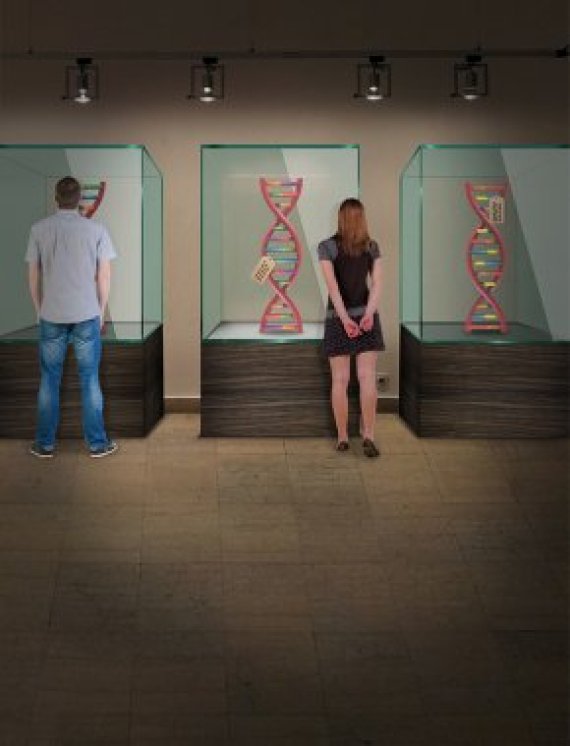Illustration Geert-Jan Bruins. Photos: Naturalis and Rob Ramaker.
The tube lighting flickers on, revealing an extraordinary spectacle. A hall filled from end to end with antelopes, deer and other hoofed animals. There are skeletons and stuffed specimens, large and small, with or without antlers. A stunning display of the diversity of life that leaves the visitor speechless. ‘Yep, so that’s it,’ says guide Steven van der Mije jestingly. Van de Mije and his colleagues manage the roughly 37 million items in Naturalis Biodiversity Centre in Leiden. Some of them came here from Wageningen: almost a million plants, for instance, most of them African, which came from Herbarium Vadense. Not to mention the 24,000 preserved flowers and fruits and 5000 dried fruits that went from Wageningen to Leiden too, or the wood samples and one million insects from the entomology collection.
But Van de Mije’s collection houses something else that is locked inside all these animals and plants: DNA, the genetic material of this collection of life forms. That may seem a trivial distinction to make, but it isn’t. Technological advances have made it easier and cheaper to actually decode this DNA. This enables researchers to ask new questions and to explore the past.
Barcode
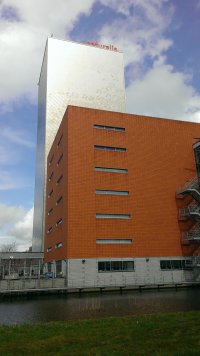
The 60 metre-high ‘animal warehouse’ of Naturalis museum in Leiden.
The main thing scientists do with the stored DNA is to convert it into ‘barcodes’, says Arjen Speksnijder, head of the laboratories at Naturalis. They might for example pull a leg off an insect or cut out a section of a bird’s foot, and use their sample to decode one specific fragment of DNA. Scientists around the world have agreed to study the same fragment so that barcodes are comparable. The codes are then fed into a database, says Speksnijder. A reliable record in which everything can be traced back to a sample and the museum piece it came from. Scientists use this database to identify animals and plants they come across.
This is more exciting than it sounds, thanks to rapidly improving techniques. Speksnijder’s clients, for example, include the ministry of Defence and Schiphol airport. If an aeroplane hits a bird it gets so mashed up by the jet engine that it is impossible to tell which species it was. But the ministry of Defence has an obligation to keep environmental impact records. ‘If you keep on hitting protected species, you do a lot of damage,’ say’ Speksnijder. He helps identify the birds that got into the jet engine and advises on flight paths.
Speksnijder works in all sorts of fields. Customs officers confiscate traditional medicines which often contain parts of protected species for which a ban on international trade applies. ‘So they don’t come with a description saying that this one contains chimpanzee or that one contains armadillo.’ But thanks to the technical advances of the last ten years, he can decipher the DNA in a pill and check whether it is on the online database. That tells you straightaway whether protected species have been used.
Millions of fragments
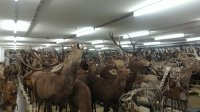
One of the depots with hoofed animals.
Most museum pieces do not tell their secrets so readily, however. They have usually undergone a lot of processing so as to preserve them for centuries. Before plants end up in a herbarium they are dried in an oven and – if they were collected in the tropics – kept in some kind of preservative for a while. These actions have a big impact on the DNA, discovered Freek Bakker, assistant professor at the Biosystematics chair group at Wageningen University. Through these treatments the DNA gets broken down into very small pieces and about 80 percent of it is no longer decipherable, probably because it gets glued together into a ball.
Nevertheless, in 2013 Bakker and his postdoc Martijn Staats succeeded in decoding almost all the genetic information –
much more than just the ‘barcodes’ – of a little plant that had been sitting in the Wageningen herbarium for 44 years. It was more difficult than it is with a ‘fresh’ plant, but once it has dried it makes no difference how old the plant is. So centuries-old plants are already being studied.
Each item presents its own challenges. The preservative commonly used on animals is notorious for ‘clicking’ DNA strings together. But Bakker and other biologists sometimes strike lucky. In recent years they have had access to equipment that can deal with DNA which has been broken down into little pieces: the perfect solution for ‘museum DNA’. The computer then puts the pieces together again.
Because of the vastness of collections such as the one at Naturalis, it will take a while before there is a barcode for every item. Standing in amongst rows and rows of laden shelves, Van de Mije gestures to the abundance around him: ‘We say we have 37 million items, but it might be 40 million for all we know.’ Only 70,000 of these have so far been allocated a barcode. And material is coming in all the time. But this is going to be big, he believes. Everything new that comes in is immediately decoded. And requests from external researchers are pouring in.
Time travel
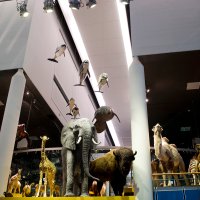
A glimpse of the public museum at Naturalis.
It’s not just the ministry of Defence and Schiphol that have interesting questions for museum collections. Many biological objects are time machines which can give us a window into the past. Where else than in a museum or at an archaeological dig can you find the DNA of dodos, Neanderthals and quaggas? Speksnijder once even inspected the stomach contents of a mammoth. By studying all the DNA fragments in it, researchers got a good impression of the creature’s last meal. ‘Then you can see which plants were growing 40 to 50 thousand years ago.’
Plant researcher Bakker hopes dried plants will prove to contain all kinds of genes that are of interest to plant breeders. Tomato plants from hundreds of years ago may contain gene variants which are no longer found in the modern variety. Bakker’s colleagues do another kind of time travel. ‘For example, one researcher, Yoshida, has described the DNA of the Phytophthora variant which contributed to the Irish potato famine,’ he says. One million Irish died in this famine between 1845 and 1850, and another million emigrated. Yoshida did this using herbarium material from German and English herbariums. ‘The cause turned out to be a short-lived one-off variety.’
Captain Cook
The possibilities can be seen at a glance in the depot. Van de Mije stops in front of a case full of stuffed birds. It is the first in a whole row, but this one is unique because all the birds in it are extinct. Probably the rarest of them all is in a tiny glass case: the Tahiti sandpiper collected by Captain Cook on his voyage across the South Pacific. The bird has never been seen since – probably wiped out by the rats brought in by the Europeans. The other two specimens that were collected have since disappeared. So Van der Mije personally cut into the sandpiper’s leg, obtaining a sample that can be used to find out about its evolution and relationship with other species.
There are limits to this time travel, however. Scientists can only go back a few hundred thousand years in time. DNA from before that time has deteriorated too badly to be decoded. But that doesn’t mean you can’t do anything, says Speksnijder. ‘The protein collagen deteriorates much more slowly and you can use variations in that to identify animal species.’ Speksnijder has his own wishlist of things he can’t research yet, but would very much like to. He would love to find out which community of bacteria – known as a microbiome – lived off the animals in the museum. ‘These bacterial communities are unique to their hosts. So it’s like a fingerprint.’
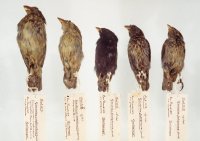
A pair of Darwin finches from the Naturalis collection.
But the experts all agree that the new technology is no substitute for the ‘old school’ work of describing and comparing the morphology, or form. Van der Mije laughs about researchers who decode the DNA of an entire bird family but then have nothing useful to say about the differences between species. Van der Mije takes obvious pleasure in dragging his guests from one depot to another, taking the lift between the 20 floors of the Naturalis tower. Racks full of pinned butterflies, long rows of cases full of fish in glass preserving jars… It goes on and on until the visitor is dizzy. And then you’ve probably only seen a fraction of the collection. Ultimately, he seems to be saying, scientists themselves must go digging for treasure in this trove of objects and DNA. ‘There’s enough work here for the next 300 years.’
Beware! DNA contamination
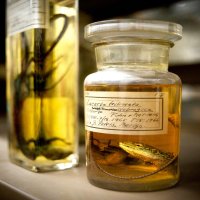
One of the biggest problems in working with old DNA is contamination with modern DNA. This mainly comes off scientists’ hands or through sloppy work in the lab. Laboratories are equipped to prevent this, says Arjen Speksnijder, head of the laboratories at Naturalis. He gives the example of how the DNA of a monkey in the museum was obtained. ‘We worked in a “clean room”, with a hairnet and two pairs of gloves on.’ A molar extracted from the animal was then sterilized with UV light. ‘We could then extract DNA from the centre.’ To prevent contamination, each step in the process – isolating, reproducing, decoding – was done in a different room.
Treasure hunt at Science Café
On April 28, Science Café Wageningen will be on the trail of the ‘Natural Treasure’ tucked away in natural history museums. The speakers will be Arjen Speksnijder, head of the laboratories at Naturalis Biodiversity Centre, and Jelle Reumer, professor of Palaeontology at Utrecht University and former director of the Natural History Museum in Rotterdam. The evening stars at 19.45 in café Loburg and admission is free.

